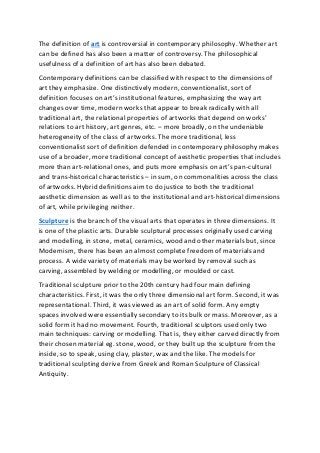
Art And Sculpture in cluture in odia.pdf
- 1. The definition of art is controversial in contemporary philosophy. Whether art can be defined has also been a matter of controversy. The philosophical usefulness of a definition of art has also been debated. Contemporary definitions can be classified with respect to the dimensions of art they emphasize. One distinctively modern, conventionalist, sort of definition focuses on art’s institutional features, emphasizing the way art changes over time, modern works that appear to break radically with all traditional art, the relational properties of artworks that depend on works’ relations to art history, art genres, etc. – more broadly, on the undeniable heterogeneity of the class of artworks. The more traditional, less conventionalist sort of definition defended in contemporary philosophy makes use of a broader, more traditional concept of aesthetic properties that includes more than art-relational ones, and puts more emphasis on art’s pan-cultural and trans-historical characteristics – in sum, on commonalities across the class of artworks. Hybrid definitions aim to do justice to both the traditional aesthetic dimension as well as to the institutional and art-historical dimensions of art, while privileging neither. Sculpture is the branch of the visual arts that operates in three dimensions. It is one of the plastic arts. Durable sculptural processes originally used carving and modelling, in stone, metal, ceramics, wood and other materials but, since Modernism, there has been an almost complete freedom of materials and process. A wide variety of materials may be worked by removal such as carving, assembled by welding or modelling, or moulded or cast. Traditional sculpture prior to the 20th century had four main defining characteristics. First, it was the only three dimensional art form. Second, it was representational. Third, it was viewed as an art of solid form. Any empty spaces involved were essentially secondary to its bulk or mass. Moreover, as a solid form it had no movement. Fourth, traditional sculptors used only two main techniques: carving or modelling. That is, they either carved directly from their chosen material eg. stone, wood, or they built up the sculpture from the inside, so to speak, using clay, plaster, wax and the like. The models for traditional sculpting derive from Greek and Roman Sculpture of Classical Antiquity.